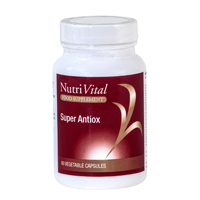The following article is aimed at informing you of what antioxidants are (and by extension what free radicals are) and what you can do to increase your supply of these vital health promoters.
We hope that you enjoy this piece. If we can be of any further assistance please don’t hesitate to contact us.
|
Antioxidants and Your Health
What Are Antioxidants?
Antioxidants are vital to our general health, without them quite simply we would cease to function!
Essentially they work in the body mainly as free radical scavengers: they mop up and neutralise these damaging substances.
The main antioxidants are:
What Are Free Radicals?
Free radicals are atoms or molecules that are capable of independent existence and are highly reactive. They are naturally occurring, formed in the body as part of normal function and also ingested/consumed quite normally.
Free radicals are so reactive due to the presence of unpaired electron(s) which makes them unstable. In nature there is a quest for stability and free radicals are no exception to this rule, in order to achieve stability steal an electron from a surrounding compound or molecule. This would be fine and well but a natural consequence is that a new free radical is formed in its place thereby a chain reaction continues.
Antioxidants – Free Radical Quenchers Antioxidants work to protect against the damaging action of free radicals because they give up their own electrons to free radicals. When a free radical gains electron(s) from an antioxidant it no longer attacks cells and tissues of the body to achieve stability and the chain reaction of oxidation is broken.
Are antioxidants at all dangerous?
After donating an electron an antioxidant becomes a free radical by definition (i.e. it has lost its stability). However in general, antioxidants in this state are not harmful because they have the ability to accommodate the change in electrons without becoming reactive.
So is it advisable to take several antioxidants in conjunction?
The key antioxidants (such as vitamin C, E and Co Q10) work synergistically and when combined can enhance the activity of each. These antioxidants help to effectively recycle each other after they have neutralised free radicals.
Do Free Radicals Have Beneficial Effects?
Free radicals reactions in the body are a necessary and normal consequence of form and function, for example:
Consequences of Free Radical Damage In their quest to achieve balance free radicals damage cells and tissues and cause instability, such as:
Free radical damage is important in the development of various conditions, notably cataracts, cancer and cardiovascular disease.
Sources of Free Radicals
Sources of Antioxidants
Foods that are rich in antioxidants are usually rich in colour. A salad from the following vital foods makes for a perfect summer snack or part of a nutritious meal.
|
| Who Would Benefit From Antioxidant Supplementation? Everyone is susceptible to free radical damage, however some people may require additional protection: if free radical load exceeds the body’s ability to cope with it.
|
|
NutriVital Super AntiOx
It has the perfect blend of ingredients carefully selected to give you a menu of cleansing plants, herbs, vitamins and minerals.
These ingredients have been combined to help anyone in need of detoxification and help for the liver as it undertakes its important role in helping the whole system stay at optimum health.
Super AntiOx contains a range of multivitamins, minerals, herbs and enzymes:
High quality vitamins/ minerals: Vitamins A, B1, B3, B5, B6 and B12 and C with strong antioxidant properties and/ or energy release from food to cells
Essential enzymes: CoQ10 for carbohydrate metabolism. Lipase and Protease to support digestive processes.
High quality plant/ herb extracts: Chaste Tree (Vitex) – Agnus castus . Provides a rich supply of flavanoids Poke root known for substantial immune support Bilbury known for offering oxygen delivery to the eyes and antioxidants
Dunellelia salina algae provides a great source of natural beta-carotine More information or buy Super AntiOx here…
NutriVital Daily Greens
Key ingredients:
Packed with green foods this is an enzyme activated, highly nutritional, alkaline-forming super food in an encapsulated form.
Acidity in the body is strongly associated with arthritis and digestive problems.
Daily Greens is an extremely useful supplement to take as a long-term maintenance program.
More information or buy Daily Greens here…
Mercola Astaxanthin
Mercola Astaxanthin with ALA (omega 3 oil) can also potentially support joint and skeletal system health, visual acuity and depth perception.
More information or buy Astaxanthin here… |
Disclaimer:
The information in this email is not intended as a substitute for medical advice. Always consult your GP and/or qualified health practitioner before making dietary changes/taking supplements.

Package contents: 60 caps
NutriVital Super Antiox is probably one of the strongest antioxidant formulas available, designed to support detoxification and prevent oxidative damage.
The NutriVital Super Antiox formula contains essential vitamins and minerals, pure plant extracts and plant enzymes to help protect cells from free radical damage and premature aging.
Our formula contains alpha